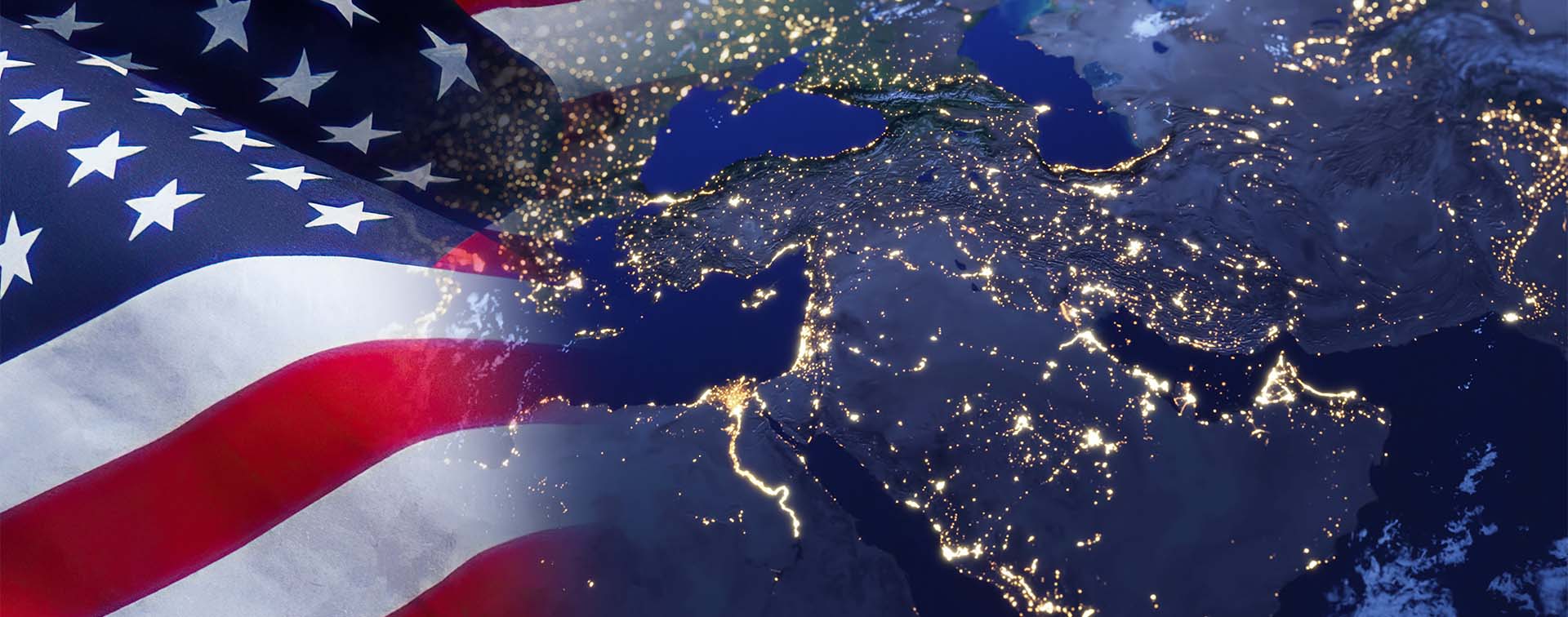
Dr. Robert Mogielnicki is a Senior Resident Scholar at the Arab Gulf States Institute in Washington and an adjunct Assistant Professor at Georgetown University.
Investment flows between the USA and the Gulf countries of the Middle East are likely to remain a robust, promising economic domain. A flurry of technology, energy, aviation, and other investment deals emerged alongside US President Donald Trump’s Middle East visit from 13–16 May. However, new challenges have emerged at both the American and Middle Eastern ends of these important investment destinations. Investors may find some comfort in the strong investment foundation between the USA and the Gulf region, but they will nevertheless seek to craft new strategies to mitigate risks stemming from rapid US policy changes and global macro-economic uncertainty.
The start of President Trump’s second term has involved a heavy dose of managing conflict, political upheaval, and uncertainty within the Middle East. The Israel–Hamas war that began before President Trump’s election grinds on after the collapse of a fragile ceasefire in March. The ousting of former Syrian President Bashar Al Assad occurred between President Trump’s election and his inauguration, while war-torn Lebanon formed a new government in February. Trump administration officials have also commenced negotiations over Iran’s nuclear program with the goal of ‘getting to a deal’.

Major deals involving US–Middle East investment collaboration are most likely to materialize with government and business actors from the Arab Gulf countries. President Trump’s May visit to the Gulf region — his first official foreign trip other than the Vatican City for Pope Francis’ funeral — was focused on major investment announcements. His three stops in Saudi Arabia, Qatar, and the UAE prioritized the member states of the Gulf Cooperation Council with the three largest economies and massive sovereign wealth funds.
The subsequent investment announcements reflect strong US and Gulf government support for more investment flows in both directions. Saudi Arabia signed a USD 142 billion defense sales agreement and launched a new AI company, Humain, that is poised to receive thousands of cutting-edge chips from Nvidia. Qatar signed agreements with Boeing and GE Aerospace worth USD 96 billion. The UAE announced plans to build one of the world’s largest AI complexes in partnership with the USA and pledged to boost its investments in the US energy sector to USD 440 billion over the next decade.
Some of these Gulf countries have already signaled a willingness to invest more in the US economy over the coming years. Saudi Crown Prince Mohammed bin Salman suggested expanding Saudi Arabia’s investment and trade with the USA by at least USD 600 billion over four years. The UAE announced a USD 1.4 trillion, 10-year investment framework with a strong focus on AI, infrastructure, semiconductors, energy, and manufacturing. And Qatar indicated its intent to generate USD 1.2 trillion in “economic exchange” with the USA. Other Gulf governments are mulling over how to calculate past, existing, and future investments in the USA. The tricky diplomatic task ahead of Gulf policymakers involves communicating these investment flows in compelling but non-committal terms.
Gulf governments, government-related entities, investment firms, and other investors have long considered investing in US assets to be a safe bet. Yet President Trump’s economic policies have produced serious pressures weighing on the American economy. The S&P 500 dropped by around 8% between the beginning of Trump’s second term and late April. The losses were closer to 14% when calculated in euros, yen, and pounds. Meanwhile, there are ongoing fears about a weakening US dollar as well as the potential for a US and global recession. J.P. Morgan raised the probability of a recession occurring in 2025 from 40% to 60%. While US stocks rebounded in May, macro-economic uncertainty persists.
Major political shifts in the USA and their economic impact will factor in broader investment calculations. Goldman Sachs Research found that “changing perceptions of US governance and institutions are also affecting the appeal of US assets for foreign investors”. But it may take time for the trendlines in US–Gulf investment flows to change significantly. Older Gulf investors with significant exposure to the USA are unlikely to drastically reconfigure their investment strategies and portfolios. Younger investors, however, may be more inclined to seek returns outside the USA over the coming years.
An agreement between the USA and China to cut tariffs temporarily and negotiate a trade deal has eased tensions around an escalating trade war. However, President Trump’s “Liberation Day” tariff hike announcement and subsequent 90-day pause on reciprocal tariffs has fueled macro-economic uncertainty. Gulf countries did not bear the brunt of tariff pressure, but President Trump’s tariff agenda may nevertheless complicate Gulf governments’ capabilities to advance key policy initiatives and strategic economic partnerships, including Gulf investments in the USA.
The uncertainty extends to longstanding economic agreements between the USA and Gulf countries. Both Oman and Bahrain (along with Israel, Jordan, and Morocco) possess free trade agreements (FTAs) with the USA, which have served as key differentiators for these countries’ efforts to facilitate two-way trade and investment flows. With the application of a baseline 10% tariff, those FTAs are effectively null and void for the time being. The perpetuation of tariff-related uncertainty is very likely to dampen investor sentiment in specific industries and sectors.
The Middle East region likewise entails a heightened geopolitical risk premium, though investors are increasingly familiar with the main sources of risk. The breakdown of a fragile ceasefire in the Israel–Hamas war has worsened the dire situation in Gaza. The USA also intensified strikes on the Houthis in Yemen in an effort to stop attacks in the Red Sea but then in early May announced a ceasefire, claiming the group has “capitulated” and would stop attacking shipping. And while the USA is negotiating with Iran over its nuclear program, the prospect of more destabilizing Iranian behavior or a military conflict with Iran looms constantly over the region.
If, against many odds, US–Iranian negotiations result in a nuclear deal involving sanctions relief, then some global investors with a high risk tolerance may begin to explore more investment opportunities in Iran. Iran’s foreign minister described such an economic opening for his country as a “trillion-dollar” opportunity for investors. This exaggerated suggestion is intended to attract the attention of the Trump administration. Middle Eastern commercial hubs — like Dubai — nevertheless stand to benefit from any renewed trade and investment interest in Iran.
Lower oil prices may likewise diminish Gulf investment capabilities, especially those of sovereign wealth funds and government-related entities in the region. There is significant downward pressure on global oil prices: Brent crude oil was trading at USD 65.41 per barrel as of 16 May. The US Energy Information Administration dropped its short-term forecast for average Brent crude oil prices in 2025 to USD 66/bbl, down from USD 75/bbl. In 2022, Brent crude oil prices stood at a much more comfortable USD 101/bbl.
If lower oil prices are sustained, there will be higher deficits and greater borrowing needs across the Gulf. Economic momentum in the region appears to be slowing, resulting in fewer new project and initiative announcements. Saudi Arabia’s government is reportedly briefing allies and industry experts that the country can manage a prolonged period of low oil prices.
President Trump understandably wants Gulf countries to invest more in the USA. For their part, Gulf governments prioritize international investments that possess a domestic dividend. Saudi Arabia aims to attract USD 100 billion in annual foreign direct investment flows by 2030. Yet foreign direct investments into Saudi Arabia fell for a third straight year in 2024, totaling USD 20.7 billion, despite a target of USD 29 billion for that year. The UAE also plans to double its gross domestic product under its “We the Emirates 2031” vision — a challenging target under the current economic environment. There is much to be done on the domestic front.
There are also competing financing needs and investment opportunities in the broader Middle East region. Following the announcement of US plans to lift sanctions on Syria, Dubai-based DP World and the Syrian government signed a USD 800 million memorandum of understanding to develop the Syrian port of Tartous. The UAE has also made major investment commitments related to the Ras El-Hekma coastal region of Egypt. Saudi Arabia likewise signaled a willingness to invest more in Egypt, and the Saudi Public Investment Fund set up an Egypt investment office in 2022. Yet Saudi investments and other forms of economic support have trickled in slowly. In November 2024, the Oman Investment Authority set up a USD 500 million joint venture with the Turkish army pension fund. Türkiye — an economic powerhouse — is a strategic investment partner for the Gulf and other Middle East countries.
Many investment decisions are driven by longer term considerations. Yet today’s challenges influence future forecasts. The head of Abu Dhabi’s Mubadala sovereign wealth fund said that global trade tensions driven by the USA will change the fund’s “base case assumptions”, though he expects the UAE to continue to invest in US technology, energy, and infrastructure. Investment flows between the USA and the Middle East will not dry up any time soon, but these consequential economic linkages are unlikely to stay static either.